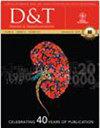{"title":"Determinants of vascular access: Patient characteristics or physician preference?","authors":"Megha Shah MD, Vijay Jain MD, Lori Spalding MD, Wajid Choudhry MD","doi":"10.1002/dat.20593","DOIUrl":null,"url":null,"abstract":"BACKGROUND \n \nThe goal of the Fistula First Initiative is to increase the use of arteriovenous fistula (AVF) for dialysis to 66% of total dialysis patients. Most facilities fall short of this target. Our objective is to determine the impact of provider bias in influencing the rate of AVF in dialysis facilities. \n \n \n \nMETHODS \n \nWe retrospectively studied 176 patients who received a new vascular access for dialysis over 18 months in two groups. In one group, a single surgeon was involved in vascular access placement (56 patients), while the other group had multiple surgeons (120 patients). \n \n \n \nRESULTS \n \nA significantly higher number of patients received AVF as their primary vascular access in the single-surgeon group, even though there were no significant differences in age, gender, and co-morbidities in the two groups. There was no difference in primary and secondary fistula failure rates. \n \n \n \nCONCLUSIONS \n \nOur study shows that AVF rate varies in different dialysis units, involving different providers, despite similar patient profiles. This implies the presence of a possible bias among providers when selecting a patient for type of access. Thus a higher rate of AVF placement, closer to the target rate, can be achieved by removing this bias. Dial. Transplant. © 2011 Wiley Periodicals, Inc.","PeriodicalId":51012,"journal":{"name":"Dialysis & Transplantation","volume":"40 9","pages":"410-412"},"PeriodicalIF":0.0000,"publicationDate":"2011-09-12","publicationTypes":"Journal Article","fieldsOfStudy":null,"isOpenAccess":false,"openAccessPdf":"https://sci-hub-pdf.com/10.1002/dat.20593","citationCount":"0","resultStr":null,"platform":"Semanticscholar","paperid":null,"PeriodicalName":"Dialysis & Transplantation","FirstCategoryId":"1085","ListUrlMain":"https://onlinelibrary.wiley.com/doi/10.1002/dat.20593","RegionNum":0,"RegionCategory":null,"ArticlePicture":[],"TitleCN":null,"AbstractTextCN":null,"PMCID":null,"EPubDate":"","PubModel":"","JCR":"","JCRName":"","Score":null,"Total":0}
引用次数: 0
Abstract
BACKGROUND
The goal of the Fistula First Initiative is to increase the use of arteriovenous fistula (AVF) for dialysis to 66% of total dialysis patients. Most facilities fall short of this target. Our objective is to determine the impact of provider bias in influencing the rate of AVF in dialysis facilities.
METHODS
We retrospectively studied 176 patients who received a new vascular access for dialysis over 18 months in two groups. In one group, a single surgeon was involved in vascular access placement (56 patients), while the other group had multiple surgeons (120 patients).
RESULTS
A significantly higher number of patients received AVF as their primary vascular access in the single-surgeon group, even though there were no significant differences in age, gender, and co-morbidities in the two groups. There was no difference in primary and secondary fistula failure rates.
CONCLUSIONS
Our study shows that AVF rate varies in different dialysis units, involving different providers, despite similar patient profiles. This implies the presence of a possible bias among providers when selecting a patient for type of access. Thus a higher rate of AVF placement, closer to the target rate, can be achieved by removing this bias. Dial. Transplant. © 2011 Wiley Periodicals, Inc.

血管通路的决定因素:患者特征还是医生偏好?
瘘第一倡议的目标是将动静脉瘘(AVF)用于透析的患者增加到总透析患者的66%。大多数设施都达不到这个目标。我们的目标是确定提供者偏见对透析设施中AVF率的影响。方法:我们回顾性研究了两组176例接受新血管通路透析治疗超过18个月的患者。在一组中,一名外科医生参与血管通路放置(56例),而另一组有多名外科医生(120例)。结果:尽管两组患者在年龄、性别和合并症方面没有显著差异,但单手术组接受AVF作为主要血管通路的患者数量明显增加。原发性和继发性瘘管失败率无差异。结论:我们的研究表明,尽管患者概况相似,但不同透析单位、不同提供者的AVF率存在差异。这意味着在选择患者的访问类型时,提供者之间可能存在偏见。因此,通过消除这种偏差,可以实现更高的AVF放置率,更接近目标速率。拨号。移植。©2011 Wiley期刊公司
本文章由计算机程序翻译,如有差异,请以英文原文为准。



